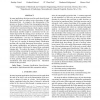Free Online Productivity Tools
i2Speak
i2Symbol
i2OCR
iTex2Img
iWeb2Print
iWeb2Shot
i2Type
iPdf2Split
iPdf2Merge
i2Bopomofo
i2Arabic
i2Style
i2Image
i2PDF
iLatex2Rtf
Sci2ools
111
click to vote
ICASSP
2011
IEEE
2011
IEEE
Sensing-aware classification with high-dimensional data
In many applications decisions must be made about the state of an object based on indirect noisy observation of highdimensional data. An example is the determination of the presence or absence of stroke from tomographic projections. Conventionally, the sensing process is inverted and a classifier is built in the reconstructed domain, which requires complete knowledge of the sensing mechanism. Alternatively, a direct data domain classifier might be constructed, but the constraints imposed by the sensing process are then lost. In this work we study the behavior of a third path we term “sensingaware classification.” Our aim is to contribute to the development of a rigorous theory for such challenging problems. end, we consider an abstracted binary classification problem with very high dimensional observations, a restricting sensing configuration, and unknown statistical models of noise and object which must be learned from constrained training data. We analyze the impact of diff...
Abstracted Binary Classification | ICASSP 2011 | Indirect Noisy Observation | Sensing | Signal Processing |
Related Content
| Added | 21 Aug 2011 |
| Updated | 21 Aug 2011 |
| Type | Journal |
| Year | 2011 |
| Where | ICASSP |
| Authors | Burkay Orten, Prakash Ishwar, W. Clem Karl, Venkatesh Saligrama, Homer H. Pien |
Comments (0)

